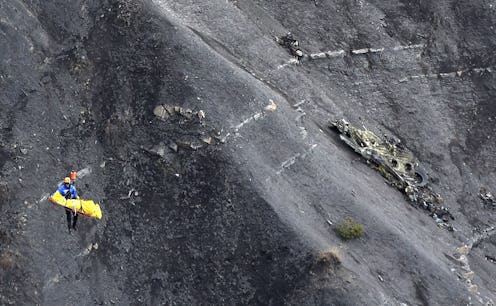News
Germanwings Rescue Workers Are Risking Their Lives
Nearly a week since Germanwings Flight 9525 crashed into the French Alps, officials are still searching for and identifying passengers. While DNA from more than half of the passengers has been found so far, the identification process of Germanwings victims hasn't been an easy one. Besides the obliteration of the aircraft, severe weather and terrain dangers are complicating the Germanwings search. As they continue to comb through the debris, sometimes dangling from high wires, rescue workers have been risking their own lives in their mission to lay passengers to rest.
For the last six days, officials have been searching for the flight's 150 passengers and second black box among debris scattered across nearly five acres of the French Alps' jagged cliffsides. The nature of the crash combined with the mountainous terrain has made the operation unprecedented in its difficulty. The plane reportedly crashed at a speed of 430 miles per hour, which completely decimated the aircraft. Unfortunately — and gruesomely — this makes finding bodies challenging for investigators, who say they've found between 400 and 600 body parts so far.The terrain has also posed challenges for the search operation. Patrick Touron, deputy director of the police's criminal research institute, told Agence France-Presse:
We have slopes of 40 to 60 degrees, falling rocks, and ground that tends to crumble. ... Some things have to be done by abseiling. Since safety is key, the recovery process is a bit slow, which is a great regret.
To manage the steep, rocky hills, Alpine police officers and forensic experts are working together in teams. Commander Emmanuel G. of the National Gendarmerie described the "complicated process" to CNN:
We are working in two-person teams, whether it's alongside (police) mountain guides, the local gendarmes or the alpine firemen and emergency teams. We do not know how to continue in this situation otherwise; we really need them to ensure our security at all times.
Some rescue workers have had to be lowered by wire from helicopters to retrieve and lift body bags from the site. Heavy winds and snowstorms in the area have made this task especially precarious, since the workers have to secure the body bags as they dangle and get lifted hundreds of feet back up into the helicopter. French prosecutor Brice Robin told AFP that an access road was being built that will hopefully allow larger vehicles to reach the crash site, which had previously been accessible only by helicopter. Robin hopes the road will be ready to use by Monday night.
Despite these treacherous conditions, forensics workers have been able to identify 86 strands of DNA so far using dental records, fingerprints, and DNA samples provided by family members. After the bodies are lifted out of the site, they are transported to the nearby town of Seyne-les-Alpes, where a team of 50 forensic doctors, dentists, and identification specialists will examine them. Passengers' personal items, like jewelry and toothbrushes, have also been used to help I.D. their owners.
As for the second black box, while investigators have found the orange cover of the second data recorder, they haven't found the box itself.
With the current terrain and weather challenges, the search is expected to continue for the duration of the week. Yves Naffrechoux, captain of rescue operations, told CNN that he hoped the entire operation will take 10 to 15 days.Images: Getty Images (4)
